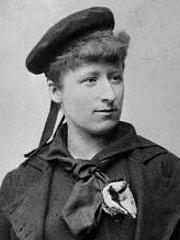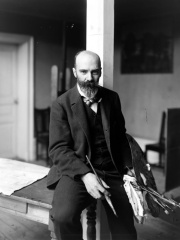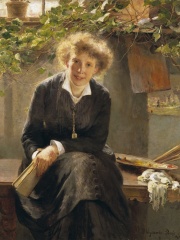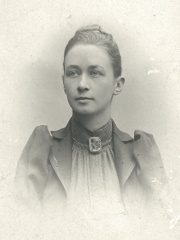
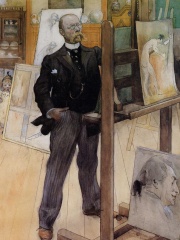
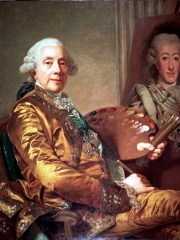
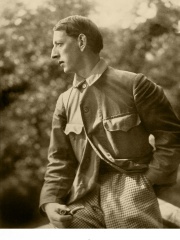
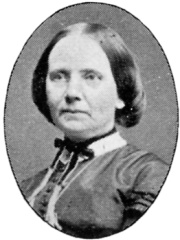
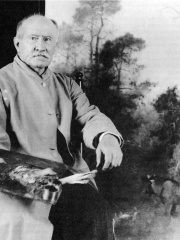
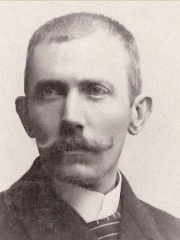
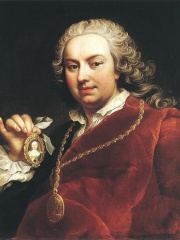
The Most Famous
PAINTERS from Sweden
Top 10
The following people are considered by Pantheon to be the top 10 most legendary Swedish Painters of all time. This list of famous Swedish Painters is sorted by HPI (Historical Popularity Index), a metric that aggregates information on a biography's online popularity. Visit the rankings page to view the entire list of Swedish Painters.

1. Hilma af Klint (1862 - 1944)
With an HPI of 74.88, Hilma af Klint is the most famous Swedish Painter. Her biography has been translated into 38 different languages on wikipedia.
Hilma af Klint (Swedish pronunciation: [ˈhɪ̂lːma ˈɑːv ˈklɪnːt]; 26 October 1862 – 21 October 1944) was a Swedish artist and mystic whose paintings are considered to be among the first major abstract works in Western art history. A considerable body of her work predates the first purely abstract compositions by Kandinsky, Malevich, and Mondrian. She belonged to a group called "The Five", a circle of women inspired by Theosophy who shared a belief in the importance of trying to contact the "High Masters", often through séances. Her paintings, which sometimes resemble diagrams, were a visual representation of complex spiritual ideas.

2. Carl Larsson (1853 - 1919)
With an HPI of 73.22, Carl Larsson is the 2nd most famous Swedish Painter. His biography has been translated into 55 different languages.
Carl Olof Larsson (Swedish pronunciation: [ˈkɑːɭ ˈlɑ̌ːʂɔn] ; 28 May 1853 – 22 January 1919) was a Swedish painter representative of the Arts and Crafts movement. His many paintings include oils, watercolors, and frescoes. He is principally known for his watercolors of idyllic family life. He considered his finest work to be Midvinterblot (Midwinter Sacrifice), a large painting now displayed inside the Swedish National Museum of Fine Arts.

3. Alexander Roslin (1718 - 1793)
With an HPI of 68.07, Alexander Roslin is the 3rd most famous Swedish Painter. His biography has been translated into 30 different languages.
Alexander Roslin (pronounced [alɛkˈsǎnːdɛr rʊsˈliːn]; spelled Alexandre in French, pronounced [alɛksɑ̃dʁ ʁɔslɛ̃]; 15 July 1718 – 5 July 1793) was a Swedish painter who worked in Scania, Bayreuth, Paris, Italy, Warsaw and St. Petersburg, primarily for members of aristocratic families. He combined insightful psychological portrayal with a skillful representation of fabrics and jewels. His style combined Classicist tendencies with the lustrous, shimmering colours of Rococo, a jocular, elegant and ornate style. He lived in France from 1752 until 1793, a period that spanned most of his career. The painting by Roslin depicting Jeanne Sophie de Vignerot du Plessis, Countess of Egmont Pignatelli, was bought by the Minneapolis Institute of Art in 2006 for US$3 million. Roslin also has pieces displayed at the Metropolitan Museum of Art.

4. John Bauer (1882 - 1918)
With an HPI of 67.12, John Bauer is the 4th most famous Swedish Painter. His biography has been translated into 42 different languages.
John Albert Bauer (4 June 1882 – 20 November 1918) was a Swedish painter and illustrator. His work is concerned with landscape and mythology, but he also composed portraits. He is best known for his illustrations of early editions of Bland tomtar och troll (Among Gnomes and Trolls), an anthology of Swedish folklore and fairy tales. Bauer was born and raised in Jönköping. At 16 he moved to Stockholm to study at the Royal Swedish Academy of Arts. While there he received his first commissions to illustrate stories in books and magazines, and met the artist Ester Ellqvist, whom he married in 1906. He traveled throughout Lappland, Germany and Italy early in his career, and these cultures deeply informed his work. He painted and illustrated in a romantic nationalistic style, in partly influenced by the Renaissance and Sami cultures. Most of his works are watercolors or prints in monochrome or muted colours; he also produced oil paintings and frescos. His illustrations and paintings broadened the understanding and appreciation of Swedish folklore, fairy tales and landscape. When Bauer was 36, he drowned, together with Ester and their son Bengt, in a shipwreck on Vättern, a lake in southern Sweden.
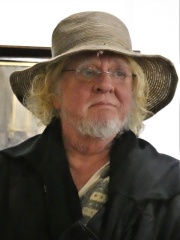
5. Odd Nerdrum (b. 1944)
With an HPI of 64.62, Odd Nerdrum is the 5th most famous Swedish Painter. His biography has been translated into 23 different languages.
Odd Nerdrum (born 8 April 1944) is a Norwegian figurative painter. A controversial figure in Norway, he is known for his anti-modernist stance. Themes and style in Nerdrum's work reference anecdote and narrative. Primary influences by the painters Rembrandt and Caravaggio help place his work in direct conflict with abstraction and conceptual art. They include still life paintings of small, everyday objects, portraits and self-portraits, and large paintings allegorical and apocalyptic in nature. The figures in Nerdrum's paintings are often dressed as if from another time and place. His work has largely been met with negative criticism from Norwegian art critics. Art critic Stig Andersen described Nerdrum as the leader of an "authoritarian personality cult" and his audience as an "uneducated, narrow-minded bourgeoisie," representing "the triumph of popular culture over art." Nerdrum was educated at Oslo Waldorf School and later at the Art Academy of Oslo. Disillusioned with the art form taught at the academy and with modern art in general Nerdrum began to teach himself to paint in a post-modern style with Rembrandt and Caravaggio as influences. In 1965, he began a several-months study with the German artist Joseph Beuys. In Fenomenet Nerdrum [The Nerdrum Phenomenon], Jan-Erik Ebbestad Hansen traces Nerdrum's sense of belonging in older cultural traditions, his skepticism toward a rationality that rejects the spiritual in nature and humanity, and his aversion to modern technology and ways of life, back to the influence of anthroposophy. Nerdrum says that his art should be understood as kitsch rather than art as such. On Kitsch, a manifesto composed by Nerdrum, describes the distinction he makes between kitsch and art. Nerdrum's philosophy spawned the Kitsch movement among his students and followers, who call themselves kitsch painters rather than artists.

6. Amalia Lindegren (1814 - 1891)
With an HPI of 62.30, Amalia Lindegren is the 6th most famous Swedish Painter. Her biography has been translated into 22 different languages.
Amalia Euphrosyne Lindegren (22 May 1814 – 27 December 1891) was a Swedish artist and painter. She was a member of the Royal Swedish Academy of Arts (1856).

7. Bruno Liljefors (1860 - 1939)
With an HPI of 61.98, Bruno Liljefors is the 7th most famous Swedish Painter. His biography has been translated into 22 different languages.
Bruno Andreas Liljefors (Swedish pronunciation: [ˈbrʉ̌ːnʊ ˈlɪ̂lːjɛˌfɔʂ] ; 14 May 1860 – 18 December 1939) was a Swedish artist. He is perhaps best known for his nature and animal motifs, especially in dramatic situations. He was the most important and probably most influential Swedish wildlife painter of the late nineteenth and early twentieth centuries. He also drew some sequential picture stories, making him one of the early Swedish comic creators.

8. Eugène Jansson (1862 - 1915)
With an HPI of 60.70, Eugène Jansson is the 8th most famous Swedish Painter. His biography has been translated into 22 different languages.
Eugène Fredrik Jansson (18 March 1862, Stockholm – 15 June 1915, Nacka) was a Swedish painter known for his night-time land- and cityscapes dominated by shades of blue. Towards the end of his life, from about 1904, he mainly painted male nudes. The earlier of these phases has caused him to sometimes be referred to as blåmålaren, "the blue-painter". Queer commentators have described Jansson as Sweden's first gay artist, a reputation based primarily on his male nudes.

9. Martin van Meytens (1695 - 1770)
With an HPI of 60.41, Martin van Meytens is the 9th most famous Swedish Painter. His biography has been translated into 17 different languages.
Martin van Meytens (24 June 1695 – 23 March 1770) was a Swedish-Austrian painter who painted members of the Royal Court of Austria such as Marie Antoinette, Maria Theresa of Austria, Francis I, Holy Roman Emperor, the Emperor's family and members of the local aristocracy. His painting style inspired many other painters to paint in a similar format.

10. Jenny Nyström (1854 - 1946)
With an HPI of 60.40, Jenny Nyström is the 10th most famous Swedish Painter. Her biography has been translated into 22 different languages.
Jenny Eugenia Nyström (13 or 15 June 1854 in Kalmar, Sweden – 17 January 1946 in Stockholm) was a painter and illustrator mainly known as the creator of the Swedish image of the jultomte on Christmas cards and magazine covers, thus linking the Swedish version of Santa Claus to the gnomes and tomtar of Scandinavian folklore.
People
Pantheon has 30 people classified as Swedish painters born between 1695 and 1944. Of these 30, 2 (6.67%) of them are still alive today. The most famous living Swedish painters include Odd Nerdrum, and Leonel Maciel. The most famous deceased Swedish painters include Hilma af Klint, Carl Larsson, and Alexander Roslin.
Living Swedish Painters
Go to all RankingsDeceased Swedish Painters
Go to all RankingsHilma af Klint
1862 - 1944
HPI: 74.88
Carl Larsson
1853 - 1919
HPI: 73.22
Alexander Roslin
1718 - 1793
HPI: 68.07
John Bauer
1882 - 1918
HPI: 67.12
Amalia Lindegren
1814 - 1891
HPI: 62.30
Bruno Liljefors
1860 - 1939
HPI: 61.98
Eugène Jansson
1862 - 1915
HPI: 60.70
Martin van Meytens
1695 - 1770
HPI: 60.41
Jenny Nyström
1854 - 1946
HPI: 60.40
Anna Palm de Rosa
1859 - 1924
HPI: 60.30
Richard Bergh
1858 - 1919
HPI: 59.89
Jeanna Bauck
1840 - 1926
HPI: 59.82
Overlapping Lives
Which Painters were alive at the same time? This visualization shows the lifespans of the 24 most globally memorable Painters since 1700.


